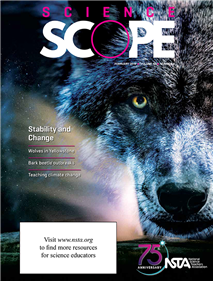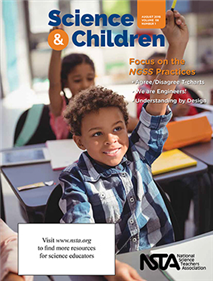All Three-Dimensional Learning resources
Journal Article
Using Storylines to Support Three-Dimensional Learning in Project-Based Science
By Jeffrey Nordine, Joseph Krajcik, David Fortus, and Knut Neumann
Journal Article
This column provides how-to strategies and practical advice for the science teacher. This issue explains how you can encourage abstract reasoning and scientific thinking through a Five Practices Discussion....
Blog Post
Using Toxic Algal Blooms to Teach Structure and Function
Young children often experience a developmental stage in which they question everything. Why aren’t there dinosaurs anymore? Why do cats purr? Why are some potato chips green? They go from simply observing their surroundings to analyzing, experimen...
By Rebecca Brewer
NSTA Press Book
Swing Set Makeover, Grade 3: STEM Road Map for Elementary School
What if you could challenge your third graders to design a swing set that’s safe but still lots of fun? With this volume in the STEM Road Map Curriculum Series, you can!Swing Set Makeover outlines a journey that will steer your students toward auth...
Blog Post
First-Graders Modeling Day and Night: Making Sense of a Phenomenon
As a first-grade teacher in Detroit with predominantly Latinx students and English language learners, I worked for several weeks at the end of last school year with a doctoral candidate in science education and former elementary teacher, Christa Have...
By Cindy Workosky
Blog Post
Recently, my colleagues and I had an exchange with some teachers in one of our professional development programs. One teacher said, “I think I do a lot of modeling in my class. I have my kids draw pictures of the science ideas they are learning all...
Blog Post
Modeling in Science Instruction
With the shift toward three-dimensional teaching and learning that the Next Generation Science Standards requires, the Crosscutting Concept of Modeling has become a major focus of my instruction. I use a process that involves revisiting the sam...
By Cindy Workosky
Journal Article
The Early Years: Making Sense of Their World
This column discusses resources and science topics related to students in grades preK to 2. In this issue students document the apparent movement of the Sun by making and recording two daily observations for a period of time and looking for a patter...
NSTA Press Book
The Power of Assessing: Guiding Powerful Practices
The Power of Assessing will show you how to use authentic assessments as a dynamic teaching tool. But this book doesn’t just describe ways to evaluate your students’ learning. Through colorful photographs and over 30 minutes of video footage you ...
By Lisa M. Nyberg, Julie V. McGough
Blog Post
What Does 3-Dimensional Space Look Like
When transitioning my classroom instruction to three dimensional learning, I decided to start with one or two areas in each unit or lesson set where I felt the most need. I was already purposeful in selecting activities that I carefully sequenced to ...
By Korei Martin
NSTA Press Book
Preparing Teachers for Three-Dimensional Instruction
It’s not enough for teachers to read through the Next Generation Science Standards (NGSS) and correlate their content to the established curriculum. Teachers must prepare to make the vision of the NGSS come alive in their classrooms. Editor Jack Rh...





